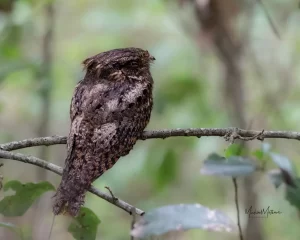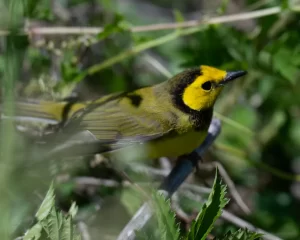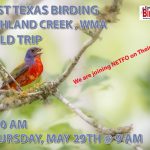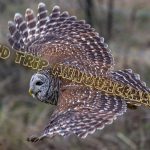Few places can put a faraway look in the eyes of birders, like the mere mention of High Island and bird migration. Talk quickly turns to hopes of making the trek this year. For some, it is an annual event. For others, it is a treasured destination—almost a rite of passage for being a birder.
Last year, I made four trips to High Island (plus Anahuac and Sabine Pass). After that trip, I decided to go down again this year and stay for a while.
So, here I am on my 11th day in bird nirvana. Well, at least for me, but many other birders feel the same way.
Most of my time has been spent in the sanctuaries in High Island, including Hooks Woods, Boy Scout Woods, Smith Oaks, and even Eubanks Woods. But there have also been side trips to Sabine Woods (my favorite), Rollover Pass, Bolivar Beach, and Anahuac. In the next few days, I also plan to visit the Galveston area.
For most days, I birded with a fellow birder, Buck Lee, but I did make this an official trip for Tyler Audubon. We had 11 birders come on that trip and had a great time. The group managed to see 122 species, and almost everyone had “lifers” in that number. (A “lifer” is the first time they had seen a particular species.)
Here are a few of the species that most of the group observed: American Redstart, Anhinga, Black Skimmer, Black Tern, Black & White Warbler, Black-crowned Night Heron, Blackpoll Warbler, Black-throated Green Warbler, Blue Grosbeak, Blue-winged Warbler, Chestnut-sided Warbler, Chuck-will’s Widow, Clapper Rail, Common Gallinule, Crested Caracara, Golden-winged Warbler, Kentucky Warbler, Least Bittern, Long-billed Dowitcher, Marbled Godwit, Nashville warbler, Northern Harrier, Northern Parula, Northern Waterthrush, Painted Bunting, Prothonotary Warbler, Purple Gallinule, Rose-breasted Grosbeak, Sandwich Tern, Scarlet Tanager, Semipalmated Plover, Spotted Sandpiper, Swainson’s Thrush, Tree Swallow, White-faced Ibis, White-tailed Hawk, Worm-eating Warbler, Yellow-billed Cuckoo, Yellow-breasted Chat, Yellow-crowned Night Heron, Yellow-throated Vireos, and many other species.
 One event birders hope for when they come is a Fall Out. What is a Fall Out? For most birders, it is a fantasy that they pray will come true. The tales of which they will share with other birders for the rest of their lives. “Ah, yes. Let me tell you about the Fall Out of <insert year> . . . “
One event birders hope for when they come is a Fall Out. What is a Fall Out? For most birders, it is a fantasy that they pray will come true. The tales of which they will share with other birders for the rest of their lives. “Ah, yes. Let me tell you about the Fall Out of <insert year> . . . “
Many birds from Central America, Mexico, and even some from South America fly across the Gulf of Mexico. They take advantage of the prevailing southerly winds to help them make this flight of hundreds of miles. But, sometimes, a cold front or another storm may blow in with winds from the north that blow in the face of the migrating birds. This, of course, tires the birds out, so at the first sight of land, they land. In other words, they FALL OUT. When this occurs, many birds may take advantage of the first land, the first shelter they see. Suddenly, where there may have been a few dozen birds in a group of trees, there may now be hundreds, if not thousands. It is an incredible sight.
 Birders often prowl the weather channels and Internet sources, hoping to see a front moving in on the coast. The diehards will have their bags packed, ready to jump in the car to head south at a moment’s notice. I speak from experience to this obsession.
Birders often prowl the weather channels and Internet sources, hoping to see a front moving in on the coast. The diehards will have their bags packed, ready to jump in the car to head south at a moment’s notice. I speak from experience to this obsession.
Fallouts don’t occur every year, and some years have more than one. You never know what the season will bring. That is why, for this year, I decided to stay for a couple of weeks, praying it would increase my odds of experiencing north winds.
And guess what happened? On one of our favorite websites for watching the wind directions, we saw the wind direction arrows point to the south. Not only were the winds going to blow to the south, but they would also be pretty intense – 15+ miles per hour most of the day. That meant a very good Fall Out was likely. And the signs were correct. It was very good.
Buck and I were in the right place. Birds, great birds, were literally everywhere. At the front drip, at least 20 Baltimore Orioles were dropping from the sky as I was standing there. They were joining a group of smaller birds—warblers and vireos of various types. It was pretty astounding.
 In all, on that day, I recorded 68 species, and that included three lifers.
In all, on that day, I recorded 68 species, and that included three lifers.
While the Tyler Audubon group missed the Fall Out, they saw many birds and seemed to have a great time. There were many smiles and exclamations of “WOW!” and “Look at that!”
It was a great trip with a great group of people. Most of them had never been to High Island during migration, and they were amazed. Great birds, great people, and when you throw in the incredible food at Tia Juanita’s in Winnie, it will be hard to beat.
Go ahead and make your plans now for 2025. It may be too early to make reservations at the hotels in Winnie, but I know they will take them six months from the desired dates. Plan on the last week in April or the first week in May. Those are usually the best times when the most numbers of birds come through.
Of course, if you want to experience a Fall Out, pack a bag and have it ready to go. Then, starting in early April, use an app or website that reports wind direction forecasts. When the winds change from the usual southerly winds to northerly, especially if they will be over ten miles per hour, hit the road quickly.
The website I like to use is windfinder.com. It is excellent. (Thanks to Buck Lee for sharing that website with me).
I look forward to seeing you there.














Related Posts
Don’t Call Me a Birdwatcher! A Birder’s Guide to the Ultimate Identity Crisis
Why Every Birder Should Use eBird: 8 Reasons It is a Game-Changer!
Where the Birds Sing: Birding Adventures From Scenic View on Lone Star Lake
East Texas Birding Trips